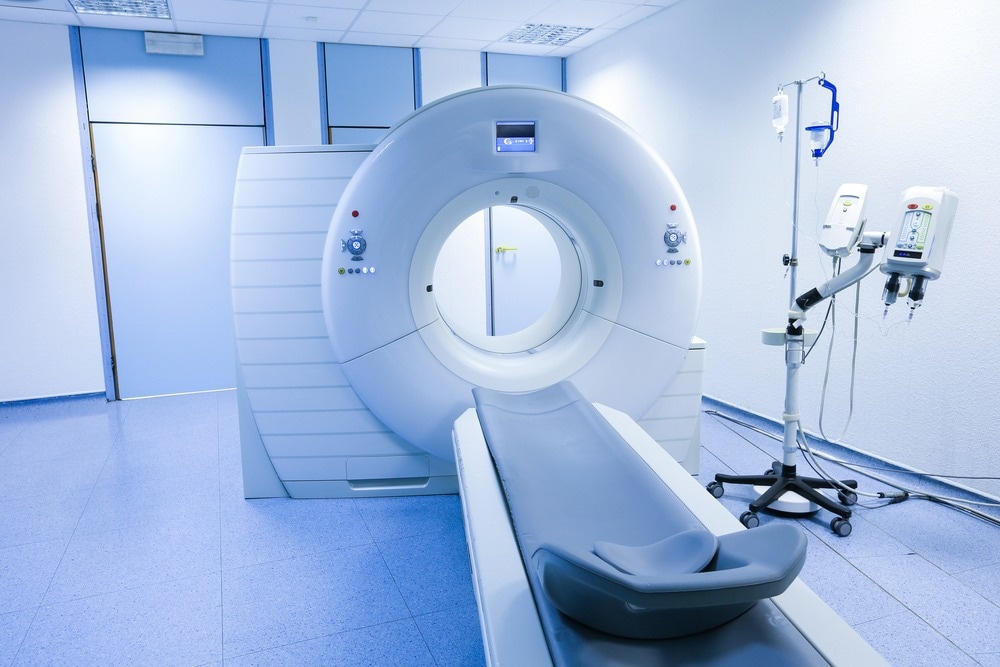Forensic pathology is the discipline that aims to determine the cause of death through the examination of a dead body. A forensic pathologist performs a postmortem examination and decides on the cause of death. Still, other information, such as the identity of the deceased, toxicological data, possible causes of injuries and can also be revealed.

Image Credit: zlikovec/Shutterstock.com
Through the years, traditional autopsy was the golden standard for forensic pathology, but nowadays, safer and less invasive methods are preferred. From the 1990s onwards, a lot of institutes implemented the scanning of corpses with the help of advanced medical imaging techniques that allow forensic pathologists to perform ‘’virtual autopsies’’.
Advanced Imaging Techniques in Postmortem Analysis
Today, cross-sectional imaging methods are applied in modern forensic medicine and pathology, with computer tomography (CT) and magnetic resonance imaging (MRI) being the most widely used. CT uses ionizing radiation or X-rays, and, with the help of an electronic detector array, an image is generated representing a ‘slice’ of the tissue of interest.
MRI scans are an effective imaging method due to the way the human body is made. All cells in the human body contain water, which means that hydrogen ions comprise the majority of ions in the human body. The magnet embedded within the MRI scanner can affect these positively charged hydrogen ions, causing them to ‘spin’ in the same direction. By exploiting these findings, layers of images can be created.
Once the magnet field is switched off, the hydrogen cations will gradually return to their original state. However, the different tissue types within the body return to their earlier states at different rates, and this phenomenon allows us to discern different body tissues.
Comparison of Virtual Autopsies (VA) vs Traditional Autopsies
Longda et al., in a three-case study, elucidated the differences between traditional and virtual autopsies. The patient in Case 1 died from acute heart disease due to cancer. Case 2 suffered multiple body wounds and a hemorrhagic shock due to a traffic accident. Case 3 also died due to wounds from a car accident and was intoxicated with alcohol prior to death. In all cases, virtual autopsy (mostly CT) was able to detect pneumatosis in soft tissues and body cavities, which was not achieved by regular autopsy.
The possibility of chest pneumatosis is usually assessed by observing the parietal pleura. However, chest pneumatosis can go undetected as it can be difficult to assess once the chest is opened, as it tends to happen in traditional autopsy. Therefore, a virtual autopsy is ideal for this kind of gas-related organ damage. Cases 2 and 3 suffered fractures and lung contusions, which were easily diagnosed in VA (plain CT with three-dimensional reconstruction).
Areas that are often overlooked, such as the face, pelvis, and spine, can be easily examined. However, due to the slice thickness of CT being only 1mm, contusions and lacerations of the brain, kidney, liver, or arteriosclerosis can be missed. Spinal cord contusions can also easily be missed due to the interference of spinal artifacts.
When it comes to the costs of using VA, most systems, such as CT, for example, are expensive to the point where most public security organizations and forensic identification institutions may not be able to afford it and, therefore, would have to cooperate with hospitals.
Legal and Ethical Considerations When It Comes to (Digital) Forensic Pathology
While law is the framework of what can be legally conducted, ethics dictate what one can morally conduct. Carew et al., in a 2023 study, explored the legal and ethical implications of autopsies (virtual and invasive) along with crime scene reconstructions in general. The outcome of this review study was the definition of ethics principles, such as anonymity, beneficence, and consent, among others, which could be incorporated into guidelines to define and support ethical practice clearly.
However, there are still a lot of issues that need addressing. Specifically, when it comes to digital tools such as digital models of human remains, it is very hard to know the origin of the bone or if consent was obtained. The lack of transparency surrounding this kind of information increases the likelihood that the digital models were created unethically.
It is also reported that 3D prints of body parts may evoke an overwhelming emotional response from the jurors like a graphic photo would do, and this is something that can affect the outcome of a trial in an unfavorable way.
The current forensic guidelines where printed remains are concerned do not clearly specify what constitutes an ethical forensic practice. Therefore, specialized training on best ethical practices would be the way forward.
Conclusion
Overall, digital forensic pathology has progressed rapidly in the past few years and, at its current state, can provide a prescreening to a conventional autopsy and come up with observations and information that would have otherwise been missed completely, such as 3D-printing of body parts for injury-weapon comparison, locating accurately specific types of fractures, diagnosing pneumatosis, pneumothorax, and even brain hemorrhages.
While traditional autopsies will still be needed for a long time, virtual autopsies could provide the majority of relevant information in the near future, especially as the technology required for this type of analysis becomes more affordable with time.
Sources
- M. Carew et al. (2023) Drilling down into ethics: A thematic review of ethical considerations for the creation and use of 3D printed human remains in crime reconstruction, Science and Justice 63(6), pp 330-342. https://doi.org/10.1016/j.scijus.2023.03.003
- Karthi Vignesh Raj K. et al. (2023) Comparative study of postmortem computed tomography (PMCT) against traditional forensic autopsy findings in fatal road traffic accidents — a pilot analysis, Egypt J Forensic Sci, 13, 21 https://doi.org/10.1186/s41935-023-00344-3
- Ma, Longda et al. (2020) Comparative Analysis of CT Virtual Autopsy and Traditional Autopsy A Report of 3 Cases Journal of Forensic Science and Medicine 6(4), pp 148-151 DOI: 10.4103/jfsm.jfsm_71_20
- Min Zhang Forensic imaging: A powerful tool in modern forensic investigation Forensic Sci Res. 2022; 7(3): 385–392 doi: 10.1080/20961790.2021.2008705
Further Reading
Last Updated: Feb 15, 2024